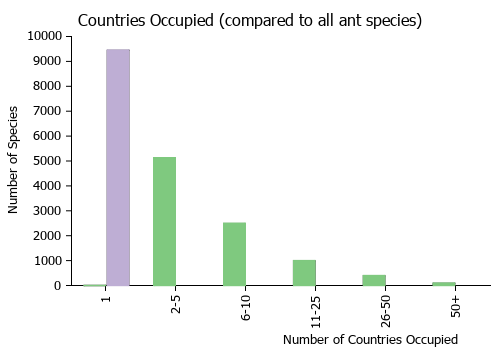Meranoplus occidentalis
| Meranoplus occidentalis | |
|---|---|

| |
| Scientific classification | |
| Kingdom: | Animalia |
| Phylum: | Arthropoda |
| Class: | Insecta |
| Order: | Hymenoptera |
| Family: | Formicidae |
| Subfamily: | Myrmicinae |
| Tribe: | Crematogastrini |
| Genus: | Meranoplus |
| Species: | M. occidentalis |
| Binomial name | |
| Meranoplus occidentalis Schödl, 2007 | |
Known from south-western and western coastal Australia.
Identification
Schödl (2007) - M. occidentalis is found in two distinct color varieties. Workers in the type series and several additional samples are light-brown with the gaster and appendages ferrugineous. Other samples have the gaster and appendages brown with the remainder of the body piceous. Intermediate forms are so far unknown. Gynes in the type sample are concolorous, males strictly bicolored. The species is not to be mixed up with any other by the large eyes and the unique promesonotal shield.
Keys including this Species
Distribution
Distribution based on Regional Taxon Lists
Australasian Region: Australia (type locality).
Distribution based on AntMaps
Distribution based on AntWeb specimens
Check data from AntWeb
Countries Occupied
| Number of countries occupied by this species based on AntWiki Regional Taxon Lists. In general, fewer countries occupied indicates a narrower range, while more countries indicates a more widespread species. |

|
Estimated Abundance
| Relative abundance based on number of AntMaps records per species (this species within the purple bar). Fewer records (to the left) indicates a less abundant/encountered species while more records (to the right) indicates more abundant/encountered species. |

|
Biology
Castes
Worker

| |
| . | |
Nomenclature
The following information is derived from Barry Bolton's Online Catalogue of the Ants of the World.
- occidentalis. Meranoplus occidentalis Schödl, 2007: 400, figs. 40, 41, 72, 79, pl. 1,C (w.q.m.) AUSTRALIA (Western Australia).
- Type-material: holotype worker, 8 paratype workers, 3 paratype queens, 4 paratype males.
- Type-locality: holotype Australia: Western Australia, Tambray, 7.vii.1987, on ground (R.P. McMillan); paratypes with same data.
- Type-depositories: WAMP (holotype); ANIC, NHMW, WAMP (paratypes).
- Distribution: Australia.
Unless otherwise noted the text for the remainder of this section is reported from the publication that includes the original description.
Description
Worker
Holotype. TL 6.10, HL 1.63, HW 1.78, FC 1.28, CS 1.70, SL 0.90, SI1 51, SI2 53, PML 1.0, PW 1.38, PMD 1.48, PMI2 107 ML 1.48, PTLL 0.43, PTLH 0.73, PTDW 0.48, PPLL 0.41, PPLH 0.74, PPI 56, PPDW 0.53, PT/PP 90.
Mandible with four teeth. In full face view clypeus anteriorly deeply excavated, distinctly exceeding anterolateral frontal corners as a bilobed carinulate projection. Head somewhat wider than long (CI 109), preoccipital margin moderately concave. Frontal carinae distinctly narrower than head width (FI 139), evenly narrowing towards clypeus. With head in profile antennal scrobe reaching beyond middle of lateral side of head, merging into lateral sides posteriorly, glossy except transverse carinulae at rear. Genae and ventrolateral sides of head evenly carinate, preoccipital lobes reticulate. Eyes exceptionally large (EL 0.43, REL 0.26, with 18 ommatidia in the longest row), situated at about middle of lateral sides of head, the dorsal ocular margin confluent with the ventral scrobal margin. Dorsal surface of head anteriorly costulate with oblique anastomoses, posterior section reticulate, with additional faint microsculpture.
Promesonotal shield distinctly wider than long (PMI 138), lateral projections translucently fused, posterior projections absent, mesonotal hind margin with transverse ridge, thus entire propodeal declivity visible from above. Propodeal spines short (PSL 0.45) and in profile broadbased, in dorsal view acute and arcuate.
Petiole in lateral view elongately trapezoid, markedly higher than long (PTI 59), with anterior face more or less straight, roundly meeting oblique reticulate dorsum, the latter merging into rugose posterior face, ventrally strongly sinuate. Postpetiole dorsally nodiform with large anterio-basal tooth.
Gaster shiny, entirely microreticulate, striate at very base. Dorsal surfaces covered with scattered pilosity of shorter decumbent and longer more or less erect soft hairs.
(n = 11). TL 6.10-7.75, HL 1.58-1.78, HW 1.78-2.10, FC 1.28-1.60, FI 131-144, CI 109-121, CS 1.70-1.94, SL 0.90-1.08, SI1 48-53, SI2 52-56, PML 1.0-1.25, PW 1.38-1.68, PMI 127-145, PMD 1.48-1.90, PMI2 107-113, ML 1.48-1.83, PSL 0.45-0.60, PTLL 0.43-0.49, PTLH 0.73-0.88, PTI 53-60, PTDW 0.48-0.65, PPLL 0.40-0.48, PPLH 0.74-0.88, PPI 50-56, PPDW 0.53-0.66, PT/PP 90-104, EL 0.37-0.44, REL, with 17-21 ommatidia in the longest row.
Holotype worker, Western Australia: 'TAMBREY WESTERN AUSTRALIA 7 AUG 1987 R.P. MCMILLAN \ ON GROUND \ Western Australian Museum Entomology Reg no. 23155' (Western Australian Museum). Paratypes. 8 workers, 3 alate gynes, 4 males, same data as holotype (WAMP, Australian National Insect Collection, Naturhistorisches Museum Wien, Vienna).
Etymology
Named for its restricted westerly distribution.
References
- Heterick, B.E. 2021. A guide to the ants of Western Australia. Part I: Systematics. Records of the Western Australian Museum, Supplement 86, 1-245 (doi:10.18195/issn.0313-122x.86.2021.001-245).
- Heterick, B.E. 2022. A guide to the ants of Western Australia. Part II: Distribution and biology. Records of the Western Australian Museum, supplement 86: 247-510 (doi:10.18195/issn.0313-122x.86.2022.247-510).
- Schödl, S. 2007. Revision of Australian Meranoplus: the Meranoplus diversus group. Memoirs of the American Entomological Institute. 80:370-424.
- Taylor, B., Agoinon, N., Sinzogan, A., Adandonon, A., Kouaguou, Y. N., Bello, S., Wargui, R., Anato, F., Ouagoussounon, I., Houngbo, H., Tchibozo, S., Todjihounde, R., Vayssieres, J.F. 2018. Records of ants (Hymenoptera: Formicidae) from the Republic of Benin, with particular reference to the mango farm ecosystem. Journal of Insect Biodiversity 8(1): 6-29 (doi:10.12976/jib/2018.08.1.2).
References based on Global Ant Biodiversity Informatics
- Schödl S. 2007. Revision of Australian Meranoplus: the Meranoplus diversus group. Memoirs of the American Entomological Institute 80: 370-424.
